Privileged user accounts are used for some of the most critical parts of a business, such as managing infrastructure and providing access to critical data for day-to-day activities. However, because privileged users have great access to your organization, they are a security threat. According to a report by Centrify, privileged credential abuse is involved in 74% of breaches.

Source: Centrify
What is a Privileged User Account?
Privileged user accounts are those that have unlimited access and permissions to systems, data or endpoints. These accounts can be used to modify data or grant permissions to other accounts. They are often given to people who work with critical data and infrastructure, such as C level executives or senior managers. Here are three common privileged user accounts most organizations use:
- Local admin accounts: These accounts provide administrative access to the local host. They are commonly used to perform maintenance on the network.
- Domain admin accounts: These are privileged accounts that have admin access across all workstations and servers within the domain.
- Service accounts: These accounts are used to operate specific applications.
Privileged Users Are a Security Weakness
Privileged user accounts can act as a security threat because it is easy for users to abuse their access without getting caught. Here are three reasons why your privilege users are your biggest security weakness.
1. Cyber criminals target privileged users: According to Verizon’s 2019 Data Breach Investigation Report, senior executives are 12 times more likely to be the target of a social engineering attack. Privileged users are targets for cyber criminals because they can use their accounts to gain a foothold into your network. Once they gain access to privileged credentials, they can change permissions for users and move around undetected. They might even try to infect other users by sending malicious links. Since they look like a normal user, their actions may not be immediately raise any red flags.
2. Accounts are difficult to manage: Privilege users are hard to manage because as employees change their roles, their permissions and accesses change as well. It can be difficult for organizations to keep track of the permissions that are required for each role and to make sure that unused accounts are deleted or that permissions are disabled when no longer required.
3. They can act as insider threats: Since privileged accounts have unlimited access, it’s hard to determine if a user is acting maliciously or not. If a privileged user is accessing confidential behaviour, are they doing it because it’s part of their job or because they are trying to leak sensitive information? They may also unintentionally act as an insider threat, such as giving a user access without determining if there was a true business need for it or not.
Securing Your Privileged Users
Since privileged users hold the keys to an organization, it’s important that organizations take necessary precautions to guard these accounts. Here are three things organizations can do to secure their privileged users.
1. Use a Zero Trust model: The foundation of Zero Trust is to “never trust, always verify”. In order to incorporate Zero Trust into your organization you need to build it into your security architecture. The strategy should include constant verification of users, devices and their access. User accounts should have multi factor authentication enabled and end devices connected to the network should be protected with endpoint security. Privilege access should be limited and given to only those who need it.
2. Implement Behavioural analytics: Using an automated detection system like Secure IT SIEM can help monitor user activity and detect potential threats. SIEM allows you to gain visibility into your network by analyzing data from devices and monitoring user behaviour. SIEM can detect indicators of potential insider threats, such as logins at unusual hours or accessing unusual data or systems.
3. Understand Your Privileged Accounts: Find out where your privileged accounts exist within your organization. Create an inventory of these accounts. This will help you gain an understanding of your company’s risk exposure. Make sure any privileged accounts that are no longer in use are deleted.




